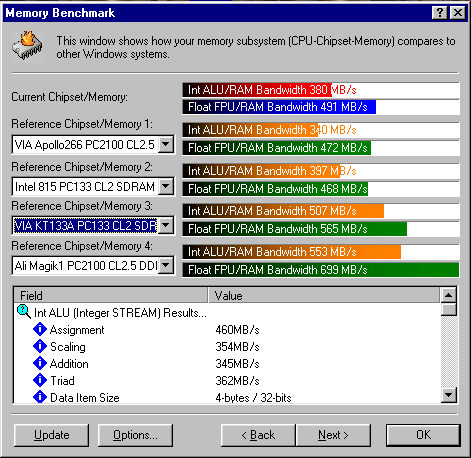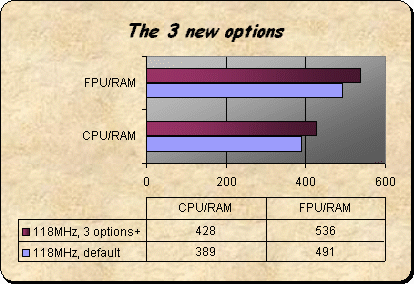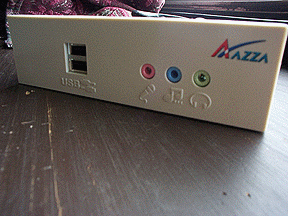Pro(266)Test
Test Setup:
- Azza 633X-AD mainboard (VIA Pro266)
- Intel Celeron FC-PGA 566MHz CPU at 952MHz (112MHz FSB)
- 128MB Samsung PC2100 CAS2.5 DDR SDRAM at CAS2 (112MHz FSB + 33%)
- Quantum Fireball Plus LM 20.5GB 7200RPM HDD
- Leadtek GeForce3, Gigabyte MX200 video cards
- Sound Blaster Live! sound card
- Nokia 447Xa 17" monitor
- Windows 98SE, DirectX 8.0, nVidia Detonator5 12.41, SiSoft Sandra 2001SE
Unfortunately for us, no matter how much we emphasized the importance of a higher FSB (especially on a truly FSB limited platform), all we had is an Intel Celeron 566MHz CPU to test with. We immediately forgot about testing at stock speed and overclocked as much as we could. This gave us a hefty FSB increase from 66MHz to 112MHz, but we were still far from where most P3 CPUs take off: 133MHz. Add to all this that the Celeron's L2 cache subsystem is severely crippled (not only the size, but latency and 8-way associativity was harmed) and we have a less than desirable platform. This also means that users with P3 processors using a high FSB can expect much higher results. Using the original shipping BIOS, with the above mentioned 3 additional RAM timig options set to the fastest values, using CAS-2 setting, 4-Way Interleaving and 112MHz + 33% asynchronous memory operation, we got the following results:

Not bad, not bad. The 633X-AD trumphed the reference Pro266 system by about 10% in average, although the reference system was using the slower CAS2.5 setting (but probably a P3 CPU and 133MHz FSB). If we raised the FSB to 118MHz, but forgot about the 3 new RAM timing settings, we got the exact same results (+/- 2 points). Now let's see what happens if we test at 118MHz with the old BIOS (everything is at max, except for the 3 new options: "118MHz noops") and with the new one (everything is at max, including the 3 new options: "118MHz max"). As "112MHz max" is equal to "118MHz noops", you can also use the following chart to compare "112MHz max" and "118MHz max", thus the influence of FSB speed.

Wow! That's a 10 percent plus for that 6MHz FSB increase! Well, to be honest, not exactly, as the equality of "112MHz noops" and "118MHz max" shows that the extra gain due to the +6MHz FSB is tarnished with the lower RAM settings. Nevertheless, it is a safe guess that using eighter setting 'ceteris paribus' (fixing everything at a certain value and only changing one variable, the FSB in this case) the RAM scores would scale linearly with the FSB. It is also worth noting that while the Pro266 chipset is far from the memory performance of the AMD based systems, it is still far better than Intel's very own i815E/EP (SDR) and since Intel does not offer any higher-end chipset for the Pentium 3 (forget i820), users seeking the best platform for their Pentium 3 processor are right when they bet on VIA.

All things must end and our review is no exception. The time has come to sum our findings up, which - in this case - is a fairly easy task. Hindered by the slower FSB (Intel's GTL+ protocol, to be exact) the Pro266 chipset cannot keep up with the similar offerings for AMD's platforms. Nevertheless, it is still the best solution for performance hungry Pentium 3 users and Pro Team Computer has built a board around it that truly deserves our greatest respect. Coming with a jumbo box including the Azza-UP Front Panel for USB and audio connections, Mandrake Linux, StarOffice, VirtualDrive the board is more feature packed than almost anything else we have seen before (although there is a lot to see!). Add decent speed, 100% stability, the full spectrum of overclocking options, great design, a superb BIOS and a low-low price and you have it all! The Pro266 chipset is definitely something which needs serious improvement, but that is not Pro Team's job. Their job is to create the best possible board for each given chipset, and with the Pro266 based 633X-AD, they might have just succeeded. Surely there are other great boards out there, possibly even better, but the 633X-AD is simply well worth its money and we really can't ask more from a mainboard.
Due to all our positive findings we hereby award the 633X-AD with our PLUS A LOT Golden Award. Congratulations!

(Marton Balog, alias Parci)













